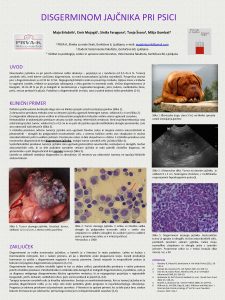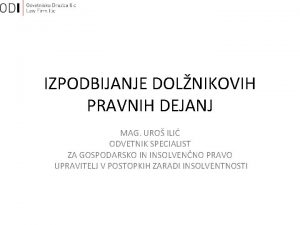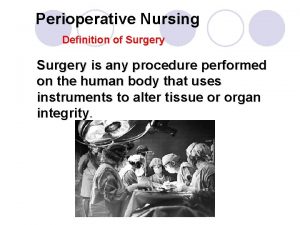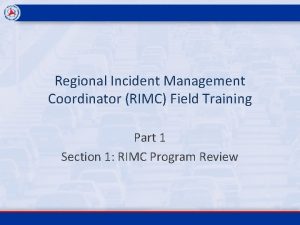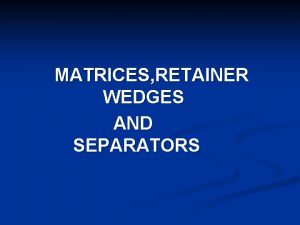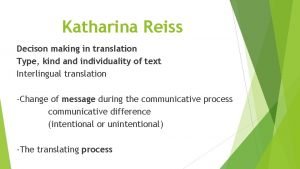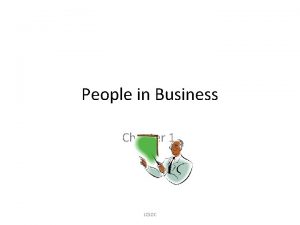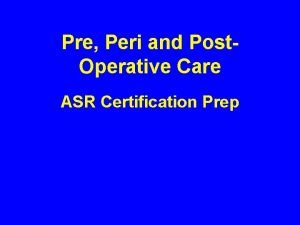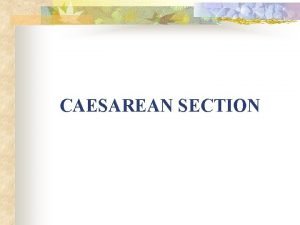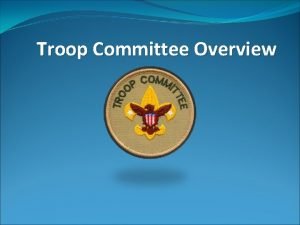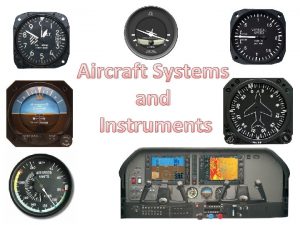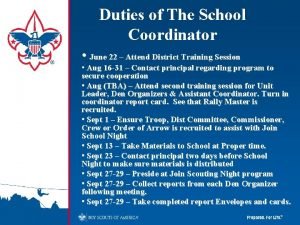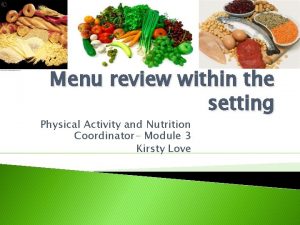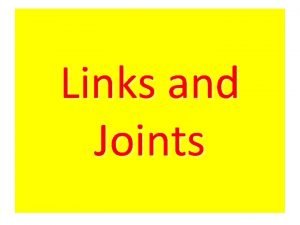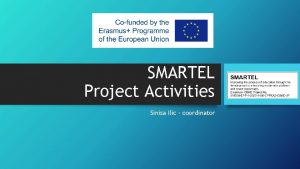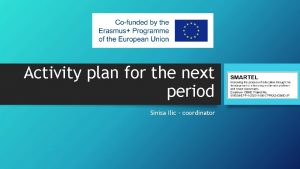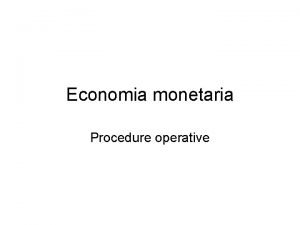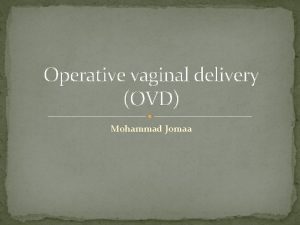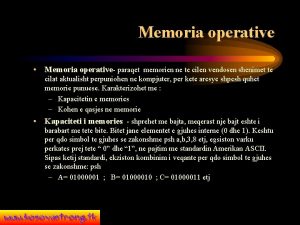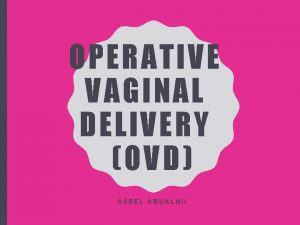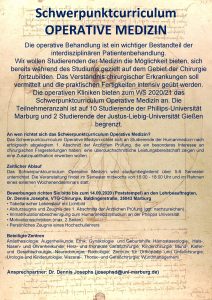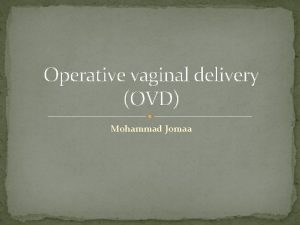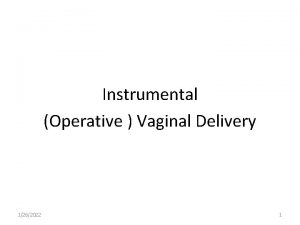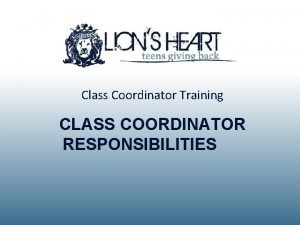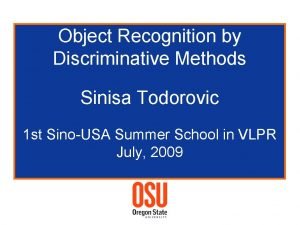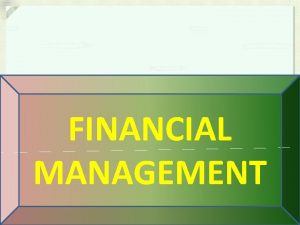Financial and operative management Sinisa Ilic coordinator Links






















- Slides: 22

Financial and operative management Sinisa Ilic - coordinator

Links to the EACEA videos on Project Management • Part A - Introduction https: //webcast. ec. europa. eu/part-a-introduction • Part B - Project Management https: //webcast. ec. europa. eu/part-b-project-management • PART C – Budget (Staff, travels, costs of stay) https: //webcast. ec. europa. eu/part-c-budget-staff-travels-costs-of-stay • PART D – Budget (equipment and subcontracting) https: //webcast. ec. europa. eu/part-d-budget-equipment-and-subcontracting • Part E - Changes to the Grant Agreement https: //webcast. ec. europa. eu/part-e-changes-to-the-grant-agreement • Part F – Reporting https: //webcast. ec. europa. eu/part-f-reporting

Contracts: Grant Agreement and Partnership Agreement • The Smartel Grant Agreement was signed by the rector of UPKM and EACEA on November 11 th 2020. • The Guidelines for the Capacity Building Partnership Agreement (the template for the PA) has been published on the website https: //eacea. ec. europa. eu/erasmus-plus/beneficiariesspace/capacity-building-in-field-higher-education-2020_en couple of days before the Grantholders meeting in Brussels • UPKM team has created the draft of the (multilateral) Partnership Agreement to be sent for a review to the partners before signing

PAYMENTS AND PAYMENT ARRANGEMENTS • EACEA has transferred 50% of the total project budget to the UPKM for the activities and costs for the first 21 months of the project. • UPKM will distribute 50% of costs foreseen for each partner to the partner’s bank account (reduced by the bank transfer fee), as soon as the multilateral contract (that is Partnership Agreement) is signed. • After providing the progress report to the EACEA for the first 21 months of the project, the consortium will request: • Remaining 40% of the project budget if consortium spends at least 70% of the first installment, or • The amount reduced by the difference between the 70% ceiling and the amount used • Partner institutions may decide to finance the last 10% of the budget from own sources, and if all costs are eligible, the EACEA will execute payment of the balance after consortium provides the final report. • There will be two exchange rates in local currencies: 1) the average of the monthly FX rates from the first 21 months and 2) the average of the monthly FX rates from the remaining 15 months. € 415, 936 is 50% € 332, 749 is 40% € 291, 155 is 70% of 50% If 270, 000 is spent by 21 st month, consortium may request: • 332, 749 – (291, 155 270, 000) = 311, 594 • •

Type of costs Cost category EU (Program) Inst. WB (Partner) Inst. Staff costs (unit) X X Travel Costs (unit) X X Costs of Stay (unit) X X Equipment Costs (actual) X Sub-contracting Costs (Actual) X

Staff costs • Staff costs are to be paid to project participants (individuals) for performing the project activities. The unit of the payment arrangement is day. Somebody may work 2 -3 hours per day, but when to be paid only a whole number of days can be paid. • Institution may decide to execute payments for staff costs on monthly / quarterly, half year, annual periods or any other periods. • In Erasmus+ projects, there are four categories for performing the project activities: Manager, Teacher, Technician and Administration. • The unit cost for each category for each country is defined by EACEA • One individual can perform activities of more than one category • For the work performed by an individual the following documents must be duly filled and signed: • Joint declaration and • Timesheet

Staff Costs • The expected number of days per partner per activity is given in Chapter E 7 of the Detailed Project Description Document (https: //smartel. pr. ac. rs/wpcontent/uploads/2021/01/detailed_project_description_SMARTEL-v 2. docx)

Staff Costs – Documents to be kept and scanned copy to be uploaded to the project portal Beside the scanned copies of Joint declaration and a Timesheet the following documents should be attached to the PDF document uploaded to the project web portal: 1. The employment contract - The individual has to be employed with the partner institution and need to have a valid employment contract 2. The financial document as a base for remuneration for the staff costs (invoice, contract for a service, or similar document) 3. The highlighted item from a bank statement report that shows a net amount transferred to the bank account of the project participant or an amount for tax and deductions transferred to an appropriate bank account 4. A KEY evidence of work that describes in more details the short descriptions stated in the Timesheet with the reference on a tangible deliverable (project deliverable, Mo. M, emails, etc. ) The name of the Staff costs document will be coded with 1. X. ACR, where 1 stands for the Staff Costs, X is the sequence number of the document and ACR is the Acronym for the institution (i. e. 1. 1. UPKM, 1. 2. UPKM, …)

Staff Costs – Example of the document • 1. 10. UPKM Joint declaration Timesheet Employment Contract for a service Bank statement KEY evidence of work

Travel costs and Costs of stay • Travel costs are unit costs and amounts are defined according to the distance between the cities of departure and destination (http: //ec. europa. eu/programmes/erasmus -plus/tools/distance_en. htm): • • between 10 and 99 KM: 20 EUR per participant 100 and 499 KM: 180 EUR per participant 500 and 1999 KM: 275 EUR per participant 2000 and 2999 KM: 360 EUR per participant • For the accommodation during the trip (sleep, local transport, food, health insurance) the price is fixed: 120 EUR per participant per day

Travel costs and Costs of stay documentation • For travel each project participant will have to duly fill Individual travel report. • The maximum number of days for the Costs of stay is: number of days of the event + days needed for the transport (maximum 2 days for decent distance) • The project participant will have to sign to attendance list of the event • The project participant will have to keep boarding passes, hotel invoices, ticket invoices, other bills • The Meeting minutes and meeting agenda of the event has to be also attached to the document, • The Travel request document needs to be attached to the document • The prove of payment of “per-diems” to the project participant (Bank statement report) • The name of the Travel and Costs of stay document will be coded with 2. X. ACR, where 2 stands for the Travel and Costs of stay, X is the sequence number of the document and ACR is the Acronym for the institution (i. e. 2. 1. IBCM, 2. 2. IBCM, …)

Travel costs and Costs of stay - example • 2. 6. UPKM Individual travel rpt. Boarding tickets Hotel Invoice Travel ticket Travel Request Mo. M Bank Statement Attendance list

Travel - purpose • There are several reasons for organizing travels during the project: • Holding the project meetings, quality board meetings, steering committee meetings, project board meetings, • Holding training sessions • Providing study visits* • Organisation of the meetings: • host will have to prepare draft Mo. M • host will have to take care of the attendance list • host will have to take care on survey on quality of the meeting

Equipment costs • Equipment must be used in the project at least in 12 months of the project • Equipment must be tax and customs exempt, EACEA will send a VAT certificate that is to be used in tax and customs exemption in national tax/customs administrations. National Erasmus offices should support the process. • Equipment costs are actual (real) costs. • For the purposes of any financial evaluation and/or audit, beneficiaries will have to be able to justify / prove the following elements: • the declared costs are identifiable and verifiable, in particular have been recorded in the accounting system of the beneficiary. • the equipment is properly registered in the inventory of the institution concerned. • The purchase of equipment must be performed in line with the lower of two: national vs EU tendering rules (when the threshold of EUR 25 000 is exceeded, tender must be launched). • In any case, the beneficiaries may not split the purchase of equipment into smaller contracts with lower individual amounts.

Equipment costs – the list of equipment • Server high performance (rack) (€ 7500) • Desktop computers and monitors (€ 11000) • licenced streaming software (per partner) (once purchased user licenses should not be renewed) (€ 3500) • Note. Books for classrooms for encoding (€ 3600) • capturing devices (cameras, mics) for smart classrooms (€ 7000) • Routers (€ 1500) • Teaching devices (projector, smart document camera, tablets, interactive white board) (€ 4000) • In total ~ € 38000 • Details are to be tailored for each institution

Equipment costs documentation • The name of the Equipment Costs will be coded with 4. X. ACR, where 4 stands for the Equipment Costs, X is the sequence number of the document and ACR is the Acronym for the institution (i. e. 4. 1. UAB, 4. 2. UAB, …) • Tender documentation • Bids • Evaluation report • Contract(s) with the winner(s) • Invoice • Bank statement items • Images of equipment (with the stickers on) • Inventory items

Subcontracting costs • Subcontracting must be tax exempt • Beneficiaries may subcontract tasks forming part of the action. If they do so, they must ensure that the following conditions are also complied with: • (a) subcontracting does not cover core tasks of the action; • (b) recourse to subcontracting is justified because of the nature of the action and what is necessary for its implementation; • (c) the estimated costs of the subcontracting are clearly identifiable in the estimated budget;

Subcontracting costs – the list • • engaging external quality experts engaging financial audit translations of official documents in English Printing the Smart. Lab book Fitting out and set up of laboratory equipment Production of promoting material, Advertising Translation of produced material in English Translation and printing the modified syllabuses

Subcontracting costs - documentation • The name of the Subcontracting Costs will be coded with 5. X. ACR, where 5 stands for the Subcontracting Costs, X is the sequence number of the document and ACR is the Acronym for the institution (i. e. 4. 1. UMN, 4. 2. UMN, …) • 3 bids / Tender document • Contract • Invoice • Bank statement item • Documenting the work with the images

Reporting • The action is divided into the following reporting periods: • Reporting period 1: from month I to month 21 (Aug 14 th 2022) • Reporting period 2: from month 22 to month 36 (Nov 14 th if not extended). • For both periods the mandatory reporting documents are: • • Narrative report (progress / final) Table of achieved results Financial report Audit report “for each beneficiary and for each affiliated entity, if maximum grant amount indicated for that beneficiary and its affiliated entities in estimated budget as reimbursement of actual costs is more than EUR 60. 000”. • Reports are to be prepared by all beneficiaries (responsible is the coordinator)

Other • During the project life-cycle the representatives of National Erasmus Office (NEO) will perform Field Monitoring in order to check whether the project activities are executed according to the plan • There is a 10% flexibility in the transfer among budget headings, i. e. each budget line can be increased to the 110% of the original value by decreasing other budget heading for the same amount. • Before doing this, coordinator should be informed • We may ask the project extension up to 1 year. • Please inform and involve students in project activities, we are doing this project in order to help them, so listen to their needs. • Please read the Programme guide and the contract for the other rules.

THANK YOU FOR YOUR ATTENTION
 Siniša faraguna
Siniša faraguna Psihologija komunikacije siniša brlas
Psihologija komunikacije siniša brlas Dr danijela filipović
Dr danijela filipović Dragan ilic monash
Dragan ilic monash Ilic romanesc
Ilic romanesc Uros ilic
Uros ilic Nursing care plan of cataract
Nursing care plan of cataract Perioperative nursing meaning
Perioperative nursing meaning Post operative nursing care
Post operative nursing care Nursing diagnosis for ocd patients
Nursing diagnosis for ocd patients Incident management coordinator
Incident management coordinator Text types examples
Text types examples Classification of wedges in dentistry
Classification of wedges in dentistry Katharina reiss
Katharina reiss Political wish
Political wish Pre post peri
Pre post peri Cesarean section slideshare
Cesarean section slideshare Hernia nursing care plan
Hernia nursing care plan Duties and responsibilities of boy scout coordinator
Duties and responsibilities of boy scout coordinator Tomato flames flaps
Tomato flames flaps School wins coordinator duties and responsibilities
School wins coordinator duties and responsibilities Physical activity and nutrition coordinator
Physical activity and nutrition coordinator Joints and links
Joints and links
